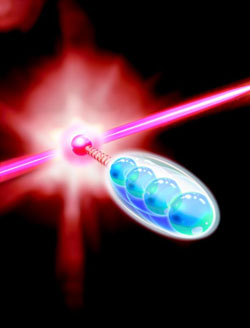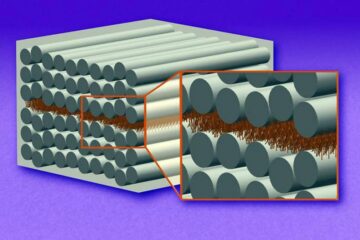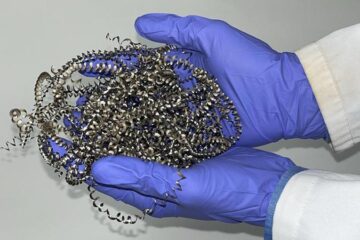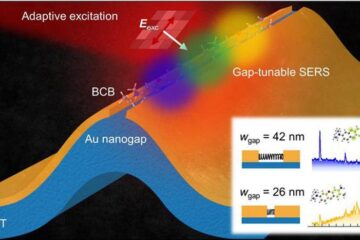Quantum simulator becomes accessible to the world

An ion interacts with the quantum system and, at the same time, establishes a controlled contact to the environment. Graphics: Harald Ritsch<br>
In an international first, Austrian quantum physicists have realized a toolbox of elementary building blocks for an open-system quantum simulator, where a controlled coupling to an environment is used in a beneficial way. This offers novel prospects for studying the behavior of highly complex quantum systems. The researchers have published their work in the scientific journal Nature.
Many phenomena in our world are based on the nature of quantum physics: the structure of atoms and molecules, chemical reactions, material properties, magnetism and possibly also certain biological processes. Since the complexity of phenomena increases exponentially with more quantum particles involved, a detailed study of these complex systems reaches its limits quickly; and conventional computers fail when calculating these problems. To overcome these difficulties, physicists have been developing quantum simulators on various platforms, such as neutral atoms, ions or solid-state systems, which, similar to quantum computers, utilize the particular nature of quantum physics to control this complexity. In a special issue at the end of 2010, the scientific journal Science chose the progress made in this field as one of the scientific breakthroughs of the year 2010.
In another breakthrough in this field, a team of young scientists in the research groups of Rainer Blatt and Peter Zoller at the Institute for Experimental Physics and Theoretical Physics of the University of Innsbruck and the Institute of Quantum Optics and Quantum Information (IQOQI) of the Austrian Academy of Sciences have been the first to engineer a comprehensive toolbox for an open-system quantum computer, which will enable researchers to construct more sophisticated quantum simulators for investigating complex problems in quantum physics.
Using controlled dissipation
The physicists use a natural phenomenon In their experiments that they usually try to minimize as much as possible: environmental disturbances. Such disturbances usually cause information loss in quantum systems and destroy fragile quantum effects such as entanglement or interference. In physics this deleterious process is called dissipation. Innsbruck researchers, led by experimental physicists Julio Barreiro and Philipp Schindler as well as the theorist Markus Müller, have now been first in using dissipation in a quantum simulator with trapped ions in a beneficial way and engineered system-environment coupling experimentally. “We not only control all internal states of the quantum system consisting of up to four ions but also the coupling to the environment,” explains Julio Barreiro. “In our experiment we use an additional ion that interacts with the quantum system and, at the same time, establishes a controlled contact to the environment,“ explains Philipp Schindler. The surprising result is that by using dissipation, the researchers are able to generate and intensify quantum effects, such as entanglement, in the system. “We achieved this by controlling the disruptive environment,“ says an excited Markus Müller.
Putting the quantum world into order
In one of their experiments the researchers demonstrate the control of dissipative dynamics by entangling four ions using the environment ion. “Contrary to other common procedures this also works irrespective of the initial state of each particle,” explains Müller. “Through a collective cooling process, the particles are driven to a common state.“ This procedure can be used to prepare many-body states, which otherwise could only be created and observed in an extremely well isolated quantum system. The beneficial use of an environment allows for the realization of new types of quantum dynamics and the investigation of systems that have scarcely been accessible for experiments until now. In the last few years there has been continuous thinking about how dissipation, instead of suppressing it, could be actively used as a resource for building quantum computers and quantum memories. Innsbruck theoretical and experimental physicists cooperated closely and they have now been the first to successfully implement these dissipative effects in a quantum simulator.
The Innsbruck researchers are supported by the Austrian Science Fund (FWF), the European Commission and the Federation of Austrian Industries Tyrol.
Publication: An Open-System Quantum Simulator with Trapped Ions. Julio T. Barreiro, Markus Müller, Philipp Schindler, Daniel Nigg, Thomas Monz, Michael Chwalla, Markus Hennrich, Christian F. Roos, Peter Zoller und Rainer Blatt. Nature 2011.
DOI: 10.1038/nature09801
Contact:
Julio Barreiro
Institute for Experimental Physics
University of Innsbruck
Phone: +43 512 507-6321
Email: julio.barreiro@uibk.ac.at
Christian Roos
Institute for Quantum Optics and Quantum Information (IQOQI)
Austrian Academy of Sciences
Phone: +43 512 507-4728
Email: christian.roos@uibk.ac.at
Christian Flatz
Public Relations
University of Innsbruck
Phone: +43 650 5777122
Email: christian.flatz@uibk.ac.at
Weitere Informationen:
http://dx.doi.org/10.1038/nature09801 – An Open-System Quantum Simulator with Trapped Ions. Julio T. Barreiro, Markus Müller, Philipp Schindler, Daniel Nigg, Thomas Monz, Michael Chwalla, Markus Hennrich, Christian F. Roos, Peter Zoller und Rainer Blatt. Nature 2011.
Media Contact
More Information:
http://www.uibk.ac.atAll latest news from the category: Physics and Astronomy
This area deals with the fundamental laws and building blocks of nature and how they interact, the properties and the behavior of matter, and research into space and time and their structures.
innovations-report provides in-depth reports and articles on subjects such as astrophysics, laser technologies, nuclear, quantum, particle and solid-state physics, nanotechnologies, planetary research and findings (Mars, Venus) and developments related to the Hubble Telescope.
Newest articles

“Nanostitches” enable lighter and tougher composite materials
In research that may lead to next-generation airplanes and spacecraft, MIT engineers used carbon nanotubes to prevent cracking in multilayered composites. To save on fuel and reduce aircraft emissions, engineers…

Trash to treasure
Researchers turn metal waste into catalyst for hydrogen. Scientists have found a way to transform metal waste into a highly efficient catalyst to make hydrogen from water, a discovery that…

Real-time detection of infectious disease viruses
… by searching for molecular fingerprinting. A research team consisting of Professor Kyoung-Duck Park and Taeyoung Moon and Huitae Joo, PhD candidates, from the Department of Physics at Pohang University…





















